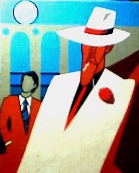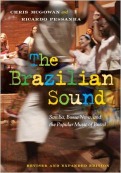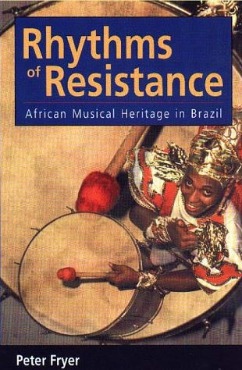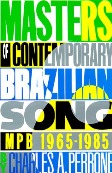Many scholars believe the origin of the word “samba” to be semba, a term in the Kimbundu language of Angola that refers to a choreographic move in which two people touch bellies as an invitation to dance (known in Portuguese as umbigada, from umbigo, meaning “navel”). The semba was a key trait of many dances brought to Northeast Brazil by enslaved Bantu people from the Kongo-Angola region of Africa. The Portuguese colonizers referred to these dances accompanied by percussion, handclapping, and singing generically as batuque. By the early 20th Century, “samba” replaced batuque as an umbrella term for such dances.
Samba de roda (“circle samba”) and partido alto (a kind of samba in the form of a “duel” between two or more singers) were two early northeastern forms of the genre that arrived in Rio with migrants from Bahia State in the latter half of the 19th Century. The lundu, modinha, maxixe, choro, and marcha are five other influential antecedents to the samba carioca (Rio samba). Of these, the lundu and maxixe are the most direct precursors to the modern samba.
The lundu pioneered the introduction of African musical traits in urban Brazilian music. First referenced in writing in 1780, the lundu was an Afro-Brazilian dance and music style that featured the semba maneuver. Considered the first black music to be accepted by Brazilian society, the lundu entered the Portuguese court by the end of the 18th Century as an elite style with guitar or piano accompaniment. The salon and street versions of the lundu both continued to be popular in Brazil until the early 20th Century. The first record made in Brazil was of a lundu called “Isto É Bom” (This Is Good), released in 1902. The song was composed by Xisto Bahia and performed by the singer Baiano for the Casa Edison record company.
The maxixe couple dance emerged in Rio around 1880 as a blend of the lundu with the European polka and Cuban habanera. Disparaged by some for its sensual moves, the maxixe soon replaced the lundu as Brazil’s most popular urban social dance and even made it to Europe in the early 20th Century. Many of the earliest recorded samba songs, released around that same time in Brazil, are rhythmically based on the maxixe.
Watch
Demonstration of the Maxixe Dance
Listen
Baiano — “Isto É Bom” (Xisto Bahia)
The first record made in Brazil was this lundu released in 1902. Compare this more Europeanized example of the genre with a more African-based one to the right.
João da Baiana — “Yaô” (Pixinguinha/Gastão Viana)
A relatively recent recording of a lundu performed by Clementina de Jesus, Pixinguinha, and João da Baiana in 1968. The latter two were pioneers of the samba in Rio. Clementina de Jesus (1902-1987) was an important singer who was acclaimed for her earthy renditions of the samba and related Afro-Brazilian roots music in the 1960s and ‘70s.
Read

Music, Culture, Brazil: An Interview with Bryan McCann

The Brazilian Sound
One of the most comprehensive books on Brazilian popular music in English with an excellent chapter on samba.

Rhythms of Resistance: African Musical Heritage in Brazil
A rich and detailed historical account of African cultural lineages in Brazilian music.

Masters of Contemporary Brazilian Song: MPB 1965-1985
A landmark work on post-bossa-nova popular Brazilian song with a succinct introduction that reviews various influential Brazilian musical trends.
Learn More
For Lifelong Learners
DISCUSSION Ideas
Discuss
• Read the essay above, then play the Radio Focus near the top of this page and link to the lundu recordings from YouTube. Have a discussion about what you hear in the music. What kinds of instruments are being used? What can you guess about what the lyrics and melodies convey?
• Share what you know about the evolution of music and dance forms in other cultures. For example, what are the roots of jazz and country music and how have these changed over time? What cultural and social influences led to the changes?
Discover
• Dance! Invite a dance instructor to your group to help you try some of the steps demonstrated in the maxixe demonstration video above.
For Students
Teaching Ideas
Discuss
• Have students read the essay above, then play the Radio Focus near the top of this page and link to the lundu recordings from YouTube. Have a discussion about what they hear in the music. What kinds of instruments are being used? What can they guess about what the lyrics and melodies convey? [Addresses CCSS Speaking and Listening Standard 4.]
Discover
• Invite students to conduct research to uncover the roots of the musical genre of their choice. They should examine how the music has changed over time, noting the social and cultural factors that have influenced the genre’s evolution.
Share
• Have students share their findings in a timeline presentation using online timeline tools. [Addresses CCSS Writing Standards 2 and 7 and Speaking and Listening Standard 4.]